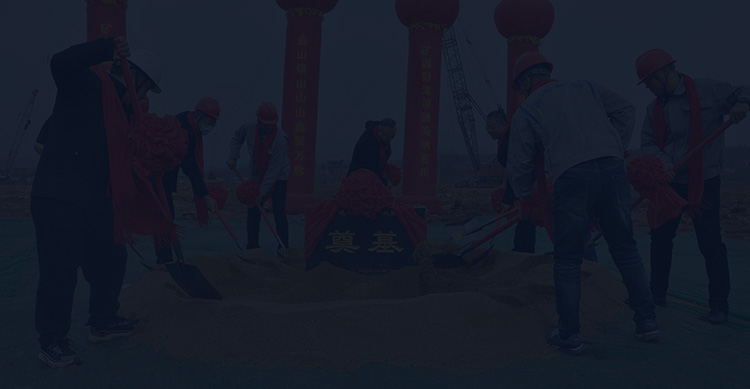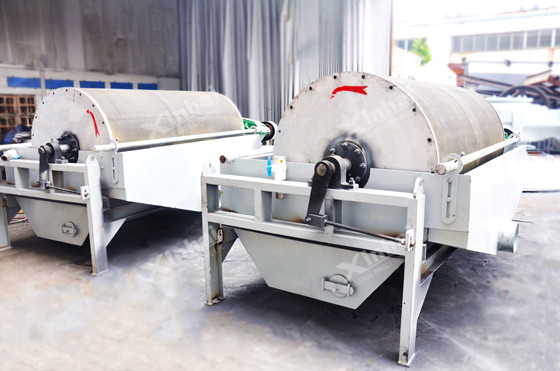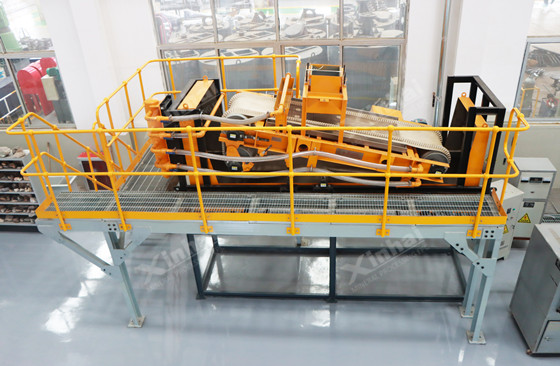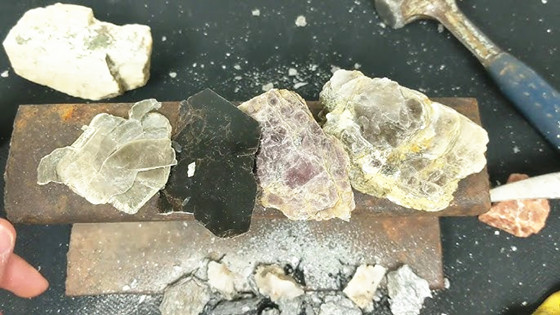
With the global surge in demand for high-grade iron concentrates and increasingly stringent tailings discharge regulations, the efficiency of magnetic separators directly determines a plant's profitability, recovery rates, and environmental compliance.
This guide, authored by senior mineral processing engineers at Xinhai Mining with over 30 years of field experience, provides a comprehensive overview of magnetic separator principles, primary types, dry vs. wet separation distinctions, and efficiency factors. Additionally, it highlights 11 magnetic separation products and shares expert maintenance insights to empower informed decisions and maximize magnetic separation performance.
All magnetic separators operate on the same principle:
They selectively attract magnetic minerals using magnetic force, separating them from non-magnetic materials.
To fully explain its operation, we break down the magnetic separation process into three key stages and outline critical factors affecting efficiency.
1. Magnetic Field Generation
Permanent magnet system (Neodymium-Iron-Boron rare earth magnets): Maintenance-free, stable magnetic field, no power consumption.
Electromagnetic systems: Adjustable field strength, suitable for high-gradient separation of fine particles.
2. Magnetic Capture Mechanism
Ferromagnetic or paramagnetic particles become magnetized within the field, forming magnetic chains or clusters that adhere to the magnetic medium (drum surface, magnetic plates, or steel wool substrate). Non-magnetic particles are carried away with the slurry or airflow.

3. Separation Process
Mineral particles enter magnetic zone → Magnetized and adsorbed
Magnetic product discharged from magnetic field via drum rotation or conveyor movement
Enter demagnetization/discharge zone → Magnetic force disappears → Product discharged.
Achieves complete separation of concentrate, middlings, and tailings.
4. Key Factors Affecting Magnetic Separation Efficiency
Magnetic field strength and gradient (higher gradient enhances capture of weakly magnetic particles)
Pole gap and magnetic wrap angle
Feed particle size and slurry concentration
Differences in mineral magnetic susceptibility
Material distribution uniformity
Xinhai offers 11 major series of magnetic separation equipment, covering various process requirements from roughing and pre-selection to ultra-fine weak magnetic recovery.
1. By Magnetic Field Strength
Weak Magnetic Separators (<400 mT): Primarily used for strongly magnetic minerals like magnetite.
High-Gradient/Strong Magnetic Separators (>1000 mT): Used for hematite, siderite, ilmenite, manganese ore, wolframite, and fine weakly magnetic tailings.
2. By Magnetic Source
Permanent magnet separators (zero energy consumption during operation)
Electromagnetic separators (real-time field strength adjustment)
3. By Operating Conditions
✦ Dry magnetic separators
01 Dry permanent magnetic drum separators — Suitable for pre-concentrating magnetite with particle size<16 mm
02 Dry permanent magnetic cylinder separators — High-capacity coarse material removal before grinding

✦ Wet Magnetic Separators
03 Wet Permanent Magnet Pre-concentration Separator – Pre-selection for grinding
04 Wet Permanent Magnet Drum Magnetic Separator (CTB/N/S Series) – Industry standard for roughing and concentration
05 Refining and Tailings Reduction Permanent Drum Separator – Increases concentrate grade by 2-4%
06 Magnetic Concentrator – Combines Concentration and Dewatering
07 Disc Magnetic Separator – Efficient Tailings Recovery
08 Vertical Ring High-Gradient Magnetic Separator (Oil-Cooled, Water-Cooled) – Recovers -400 mesh weakly magnetic minerals
09 Wet High-Intensity Magnetic Plate Separator – Recovers ultrafine hematite, limonite, manganese ore

4. Auxiliary Magnetic Equipment
10 Electromagnetic Iron Removers (RCDC, RCDF Series) — Belt protection and iron removal
11 Metal Detectors — Prevent metal damage to downstream crushers and mills

A magnetic separator may look similar from the outside, but wet and dry separation have very different roles.
1. Ore Conditions
Condition | Dry Separation | Wet Separation |
Moisture | Low moisture, dry feed | Mixed with water |
Particle size | Coarse (≤16 mm) or dry powders | Fine to ultra-fine |
Ore types | Magnetite, steel slag, waste rock | Magnetite, hematite, manganese, tailings |
2. Process Performance
Wet magnetic separation
Higher recovery
Better handling of fine particles
More stable concentrate grade
Lower cost
Ideal for pre-concentration and waste rejection
No water required → excellent for dry regions
3. Application Examples
Dry Magnetic Pulley: Waste rock rejection before grinding
Wet Permanent Drum: Mainstream magnetite beneficiation
Vertical Ring High-Gradient Separator: Recovery of weak magnetic fine particles
The biggest challenge for mineral processing plants is not “lack of equipment options” but “mismatched equipment and process,” which leads to low recovery rates, high energy consumption, and frequent failures. Below is the step-by-step guide:
Step 1: Analyze Ore Type & Magnetic Susceptibility

Ore type dictates required magnetic strength—non-negotiable. Xinhai’s mineral testing measures susceptibility and guides selection:
Strong Magnetic Minerals (magnetite, pyrrhotite; susceptibility >10⁻³ cm³/g): Weak magnetic separators suffice (e.g., wet cylinder for roughing, dry drum for pre-concentration).
Weak Magnetic Minerals (hematite, ilmenite; 10⁻⁶–10⁻³ cm³/g): High-gradient/strong magnetic separators mandatory (e.g., vertical ring for fine grains, disc for placer ores).
Non-Magnetic Minerals with Impurities (quartz, kaolin): wet strong magnetic plate separator for iron removal, ensuring purity.
Step 2: Confirm Particle Size & Process Stage
Particle size and process position (pre-grinding, grinding, tailings) directly determine equipment type:
Process Stage | Typical Particle Size | Recommended Xinhai Equipment | Core Advantage |
Pre-grinding Pre-concentration | 5–20mm | Dry Permanent Magnetic Drum / Wet Permanent Magnetic Pre-separator | Early gangue discarding, reduced grinding load |
Grinding Circuit Roughing | 0.1–2mm | Wet Permanent Magnetic Cylinder Separator | High throughput, stable recovery |
Concentrate Upgrading | <0.1mm | Concentrate Upgrading Permanent Magnetic Cylinder | Grade improvement to smelting standards |
Tailings Reprocessing | <0.074mm | Vertical Ring High-Gradient Separator | Fine weak magnetic mineral recovery, zero waste |
Step 3: Define Quality & Economic Targets
Concentrate grade, recovery, and budget narrow options:
High Grade Priority (e.g., >67% iron): Prioritize precision— concentrate upgrading separator + wet strong magnetic plate separator for deep purification.
High Recovery Priority (e.g., tailings reprocessing): Strong capture equipment—vertical ring separator + concentrating separator for maximum recovery.
Budget-Conscious (Small Plants): Cost-effective permanent magnetic models—dry cylinder (dry processing), wet cylinder (wet processing); avoid high-cost electromagnetic systems.
Step 4: Factor in Operational & Maintenance Capabilities
For remote sites or teams with limited maintenance, simplicity and durability are key: Xinhai’s permanent magnetic need only monthly inspections, while electromagnetic require quarterly coil insulation checks. All Xinhai equipment includes a 2-year warranty and global on-site service, addressing maintenance concerns.
Note: The above magnetic separation equipment selection is for reference only; actual selection depends on the specific conditions of the mine site.

Check the magnetic system demagnetization rate every 6 months (<2% normal)
Inspect the drum skin/magnetic plate wear layer thickness monthly
Monitor bearing temperature and drive chain tension
Ensure uniform feeding (uneven feeding reduces recovery by 3–5%)
Electromagnetic equipment: check coil temperature rise (<70°C) and insulation resistance
Wet equipment: daily tank flushing to prevent magnetic medium blockage
Vertical ring: clean steel wool matrix every 800–1000 hours
The global magnetic separation industry includes several established manufacturers, but few cover the entire value chain from laboratory testing to plant EPC.
Xinhai’s magnetic separators operate in 100+ countries, including Australian iron ore plants, South African manganese projects, and Chinese tailings lines. A standout example: A 1 million t/a Brazilian iron ore EPC project used Xinhai’s full magnetic separation suite, achieving 67.5% concentrate grade and 96% recovery—3% above client expectations.

This guide covers every critical decision point from principles and model selection to long-term maintenance. Whether you're upgrading an existing plant or building a new one, Xinhai's 11 series of magnetic separation equipment and over 30 years of engineering expertise ensure you receive the optimal solution. Looking to boost ore recovery rates and reduce operational costs?
Contact Xinhai today for a ore magnetic separation test report and customized magnetic separation flowchart.
To find out more about our products and solutions, please fill out the form below and one of our experts will get back to you shortly.